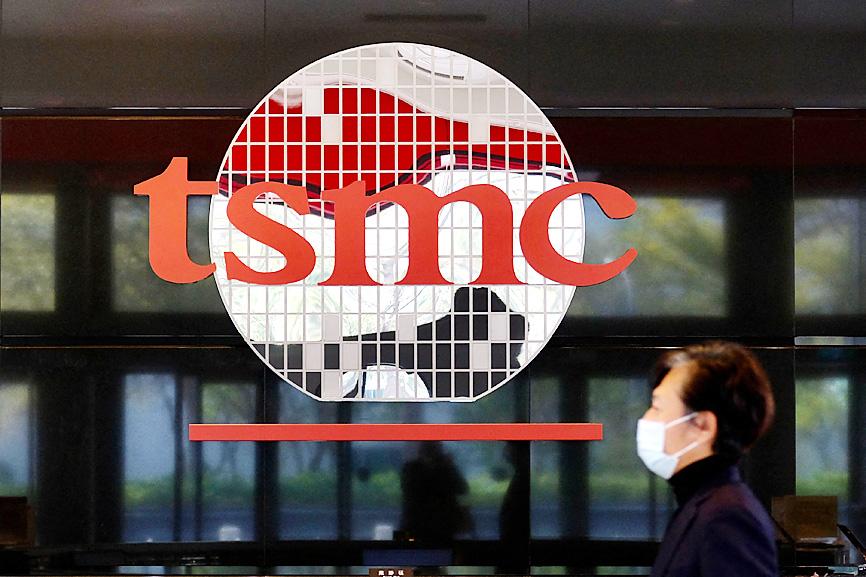Taiwan Semiconductor Manufacturing Co (TSMC, 台積電) plans to invest about US$100 billion to expand capacity and fund research and development (R&D) of advanced technologies in the next three years to keep up with rising demand, it said yesterday.
TSMC unveiled the rare multiyear investment plan to appease customer panic over a global chip shortage.
“We are entering a period of higher growth as the multiyear megatrends of 5G and HPC [high-performance-computing] are expected to fuel strong demand for our semiconductor technologies in the next several years,” TSMC said in a statement.

Photo: Sam Yeh, AFP
In addition, the COVID-19 pandemic has accelerated digitalization, which also drives semiconductor demand, the chipmaker said in the statement.
TSMC made the comments after China-based media Voice reported about the chipmaker’s grand capital investment plan and price adjustments, citing a letter sent by TSMC chief executive officer C. C. Wei (魏哲家) to customers. TSMC declined to comment on pricing.
TSMC has been improving productivity and boosting factory utilization to more than 100 percent over the past 12 months, but has not been able to keep up with demand, Wei said in the letter obtained by the Taipei Times.
The chipmaker is taking more actions to avert future supply crunches, it said.
“TSMC will be building greenfield [new] fabs and expanding existing fabs for both leading-edge and specialty technologies,” Wei said. “We have started hiring thousands of new employees, acquired land and equipment, and started construction of new facilities at multiple sites globally.”
TSMC operates 13 wafer manufacturing factories in Taiwan and China, and is building a new fab in Arizona. Based on the company’s first-phase plan, the US plant would produce 20,000 12-inch wafers per month after it opens in 2024.
TSMC in January budgeted record-high capital expenditure of US$25 billion to US$28 billion for this year, citing technology complexity, technology advancement and high costs of extreme ultraviolet lithography tools.
“Increased capacity will improve supply certainty and help protect complex global supply chains that rely on semiconductors,” Wei said.
In the letter, Wei told customers TSMC would suspend wafer price discounts through the whole of next year, starting on Dec. 31.
“We believe that this modest action is the least disruptive option to supply chains so that TSMC can deliver on our mission of providing leading semiconductor technologies and manufacturing capacity in a sustainable manner,” Wei said.
While most chipmakers have hiked prices by 30 or 40 percent to reflect surging raw material costs and volatile foreign-exchange rates, TSMC has tried to keep prices stable.
Separately, United Microelectronics Corp (UMC, 聯電) yesterday said it would invest more to expand capacity at its factories in Tainan over the next 3 years, in addition to the NT$350 billion (US$12.27 billion) it has spent on capital expenditures over the past decade.
UMC is to spend US$1.5 billion on new facilities and equipment this year, mainly on increasing its 28-nanometer chip capacity, it told investors in January.

Conflict with Taiwan could leave China with “massive economic disruption, catastrophic military losses, significant social unrest, and devastating sanctions,” a US think tank said in a report released on Monday. The German Marshall Fund released a report titled If China Attacks Taiwan: The Consequences for China of “Minor Conflict” and “Major War” Scenarios. The report details the “massive” economic, military, social and international costs to China in the event of a minor conflict or major war with Taiwan, estimating that the Chinese People’s Liberation Army (PLA) could sustain losses of more than half of its active-duty ground forces, including 100,000 troops. Understanding Chinese

The Ministry of Foreign Affairs (MOFA) yesterday said it is closely monitoring developments in Venezuela, and would continue to cooperate with democratic allies and work together for regional and global security, stability, and prosperity. The remarks came after the US on Saturday launched a series of airstrikes in Venezuela and kidnapped Venezuelan President Nicolas Maduro, who was later flown to New York along with his wife. The pair face US charges related to drug trafficking and alleged cooperation with gangs designated as terrorist organizations. Maduro has denied the allegations. The ministry said that it is closely monitoring the political and economic situation

UNRELENTING: China attempted cyberattacks on Taiwan’s critical infrastructure 2.63 million times per day last year, up from 1.23 million in 2023, the NSB said China’s cyberarmy has long engaged in cyberattacks against Taiwan’s critical infrastructure, employing diverse and evolving tactics, the National Security Bureau (NSB) said yesterday, adding that cyberattacks on critical energy infrastructure last year increased 10-fold compared with the previous year. The NSB yesterday released a report titled Analysis on China’s Cyber Threats to Taiwan’s Critical Infrastructure in 2025, outlining the number of cyberattacks, major tactics and hacker groups. Taiwan’s national intelligence community identified a large number of cybersecurity incidents last year, the bureau said in a statement. China’s cyberarmy last year launched an average of 2.63 million intrusion attempts per day targeting Taiwan’s critical

AGING: As of last month, people aged 65 or older accounted for 20.06 percent of the total population and the number of couples who got married fell by 18,685 from 2024 Taiwan has surpassed South Korea as the country least willing to have children, with an annual crude birthrate of 4.62 per 1,000 people, Ministry of the Interior data showed yesterday. The nation was previously ranked the second-lowest country in terms of total fertility rate, or the average number of children a woman has in her lifetime. However, South Korea’s fertility rate began to recover from 2023, with total fertility rate rising from 0.72 and estimated to reach 0.82 to 0.85 by last year, and the crude birthrate projected at 6.7 per 1,000 people. Japan’s crude birthrate was projected to fall below six,